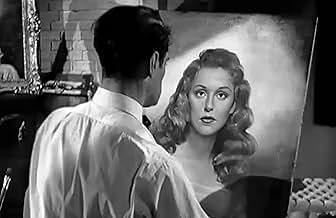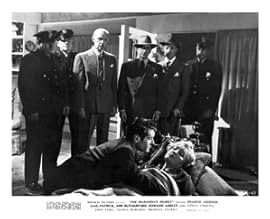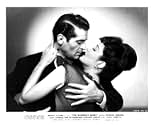NOTE IMDb
6,4/10
310
MA NOTE
Ajouter une intrigue dans votre langueThe sister of a murdered model poses for the same artist to try to catch her killer.The sister of a murdered model poses for the same artist to try to catch her killer.The sister of a murdered model poses for the same artist to try to catch her killer.
- Réalisation
- Scénario
- Casting principal
Michael St. Angel
- Hunt Mason
- (as Michael Hawks)
Bob Alden
- Office Boy
- (non crédité)
James Carlisle
- Doctor
- (non crédité)
Tanis Chandler
- Singer
- (non crédité)
Anne Chedister
- Madonna
- (non crédité)
Gino Corrado
- Boucher - Waiter
- (non crédité)
Avis à la une
This is one of these murder mysteries where we, the audience, are clued in from the start. It's up to the stars to decide whether or not tortured artist "Corbin" (Francis Lederer) is responsible for a murder in Paris (for which he was acquitted) and another in the US. Both women had been his model as some stage, so the finger well and truly points in his direction. It falls to the murdered girl's sister "Linda" (Ann Rutherford) to pose as his latest model whilst he paints both her portrait, and that of the wealthy "Ella" (Gail Patrick) - who might be next for the chop? It's actually quite a wordy exercise, this, with no stand out efforts and little by way humour or jeopardy. Moves along quickly though, and the production is pretty competent. Not a film you'll remember but not one you're likely to hate either.
Not sure if this strictly a noir film as it runs as a mystery as well. Some evidences of film noir would be the dramatic cinematography, a character that is somewhat of a Femme Fatale, a feeling of hopelessness in the current status quo, and of course, the criminal element that pervades most scenes. Against it being noir would be that this film is not about the average man, but a well to do artist. Also, the fate angle doesn't seem quite pronounced here. The acting is great throughout with special kudos for Francis Lederer and his creepy accent. The cinematography is uniformly superb. Of course, any film shot by John Alton is special. This is a rare film and currently only shown at film festivals. Hopefully it will show up on DVD someday.
Ambience Provided by Top-Notch Film-Noir Cinematographer John Alton.
The Film is Painted with Diagonals and Shadows.
It's a Melodramatic Mystery about a Successful Painter that has His Models being Murdered One After Another.
He has Bouts of Amnesia and Other Mental Problems and He Can't Remember if He's Responsible or Not.
Somewhat Far-Fetched and Contrived Story to Fit All the Murders into an 80min Time-Frame and it Mostly Works with some Good Acting.
The Film Reeks of Melancholia and Frank Lederer in the Lead is a Gamut of Gaunt Features and Droopy Demeanor.
One of the Suspects Completely Disappears in the Third-Act. Playing an Important Role in Acts 1 & 2, and then He just Vanishes.
Such are the Pitfalls in the B-Movie World of Programmers where it was a "Just Get It Done" Attitude for the Most Part.
A Surreal Night-Club Scene in "The Village", with a Knife-Throwing Act is Bizarre.
This One Rises Above its Pedigree because of Alton's Images, Lederer's Laconic Portrayal, and a Good Twist.
Above Average.
The Film is Painted with Diagonals and Shadows.
It's a Melodramatic Mystery about a Successful Painter that has His Models being Murdered One After Another.
He has Bouts of Amnesia and Other Mental Problems and He Can't Remember if He's Responsible or Not.
Somewhat Far-Fetched and Contrived Story to Fit All the Murders into an 80min Time-Frame and it Mostly Works with some Good Acting.
The Film Reeks of Melancholia and Frank Lederer in the Lead is a Gamut of Gaunt Features and Droopy Demeanor.
One of the Suspects Completely Disappears in the Third-Act. Playing an Important Role in Acts 1 & 2, and then He just Vanishes.
Such are the Pitfalls in the B-Movie World of Programmers where it was a "Just Get It Done" Attitude for the Most Part.
A Surreal Night-Club Scene in "The Village", with a Knife-Throwing Act is Bizarre.
This One Rises Above its Pedigree because of Alton's Images, Lederer's Laconic Portrayal, and a Good Twist.
Above Average.
The Madonna's Secret (1946)
A psycho-mystery that broods and clunks along pretty well but too much a twist on a twist kind of movie. In fact, it's so obvious that the main character, a tortured artist, is suspected from the first minute, you know something else is up. What you don't suspect is what, and so by the end there is that final twist. I suppose this should or could have been a Vincent Price Gothic chiller, but in the hands of the leading man, Francis Lederer, it's a dark and serious affair. No camp allowed.
This comes near the end of director William Thiele's B-movie career (followed by a slew of Lone Ranger t.v. episodes and then, a step sideways for 36 shows of Cavalcade of America, a staple of 1950s American middlebrow normalcy). So we might be glad the movie is as good as it is, and I think the main reason is ace cinematographer John Alton. There are subtle movements of the camera that make an ordinary conversation take on depth, at least in terms of mise-en-scene. And the truly dramatic lighting (including some obvious back projection stuff of Lederer speeding in a boat at night) is great just to watch.
The series of women who pose and/or get themselves killed is curious--they do all look the same at a glance--and might have been more fun if extended a bit more. That is, they are all relatively cardboard characters, including the main character, who can't get out of his angst filled cliché, and so we can't really get involved emotionally in their fates. We just watch. And so thank you Mr. Alton for making that watching worth the ride. If you don't give a hoot about lights and camera, give this a by.
A psycho-mystery that broods and clunks along pretty well but too much a twist on a twist kind of movie. In fact, it's so obvious that the main character, a tortured artist, is suspected from the first minute, you know something else is up. What you don't suspect is what, and so by the end there is that final twist. I suppose this should or could have been a Vincent Price Gothic chiller, but in the hands of the leading man, Francis Lederer, it's a dark and serious affair. No camp allowed.
This comes near the end of director William Thiele's B-movie career (followed by a slew of Lone Ranger t.v. episodes and then, a step sideways for 36 shows of Cavalcade of America, a staple of 1950s American middlebrow normalcy). So we might be glad the movie is as good as it is, and I think the main reason is ace cinematographer John Alton. There are subtle movements of the camera that make an ordinary conversation take on depth, at least in terms of mise-en-scene. And the truly dramatic lighting (including some obvious back projection stuff of Lederer speeding in a boat at night) is great just to watch.
The series of women who pose and/or get themselves killed is curious--they do all look the same at a glance--and might have been more fun if extended a bit more. That is, they are all relatively cardboard characters, including the main character, who can't get out of his angst filled cliché, and so we can't really get involved emotionally in their fates. We just watch. And so thank you Mr. Alton for making that watching worth the ride. If you don't give a hoot about lights and camera, give this a by.
Francis Lederer is a painter haunted by his past, using Linda Stirling as his model, but painting the face of his dead model in Europe. He was a suspect in her murder by drowning, but nothing concrete was proven, and so he went free and came to America.
Now he has fallen in love with Miss Stirling and now she too is dead of drowning. Police detective John Litel hounds him, but he has an alibi, and suggests he has an enemy. The cops have to let him go, but they play a spy in his home. Is it Miss Stirling's sister, an actress, or is it rich Gal Patrick, who wishes to buy Lederer's last painting because of the notoriety, or is it Ann Rutherford, who says she has been sent by the modeling agency? Lederer hires her, and while she is changing, he looks in her hand bag and discovers a gun.
It's in interesting set-up for a film noir, and DP John Alton shoots strong, sharp shadows of prison bars. William Thiele directs from a script he co-wrote. It's a good cast, and worth a look, despite a slightly botched ending.
Now he has fallen in love with Miss Stirling and now she too is dead of drowning. Police detective John Litel hounds him, but he has an alibi, and suggests he has an enemy. The cops have to let him go, but they play a spy in his home. Is it Miss Stirling's sister, an actress, or is it rich Gal Patrick, who wishes to buy Lederer's last painting because of the notoriety, or is it Ann Rutherford, who says she has been sent by the modeling agency? Lederer hires her, and while she is changing, he looks in her hand bag and discovers a gun.
It's in interesting set-up for a film noir, and DP John Alton shoots strong, sharp shadows of prison bars. William Thiele directs from a script he co-wrote. It's a good cast, and worth a look, despite a slightly botched ending.
Meilleurs choix
Connectez-vous pour évaluer et suivre la liste de favoris afin de recevoir des recommandations personnalisées
Détails
- Durée
- 1h 19min(79 min)
- Couleur
- Rapport de forme
- 1.37 : 1
Contribuer à cette page
Suggérer une modification ou ajouter du contenu manquant





















